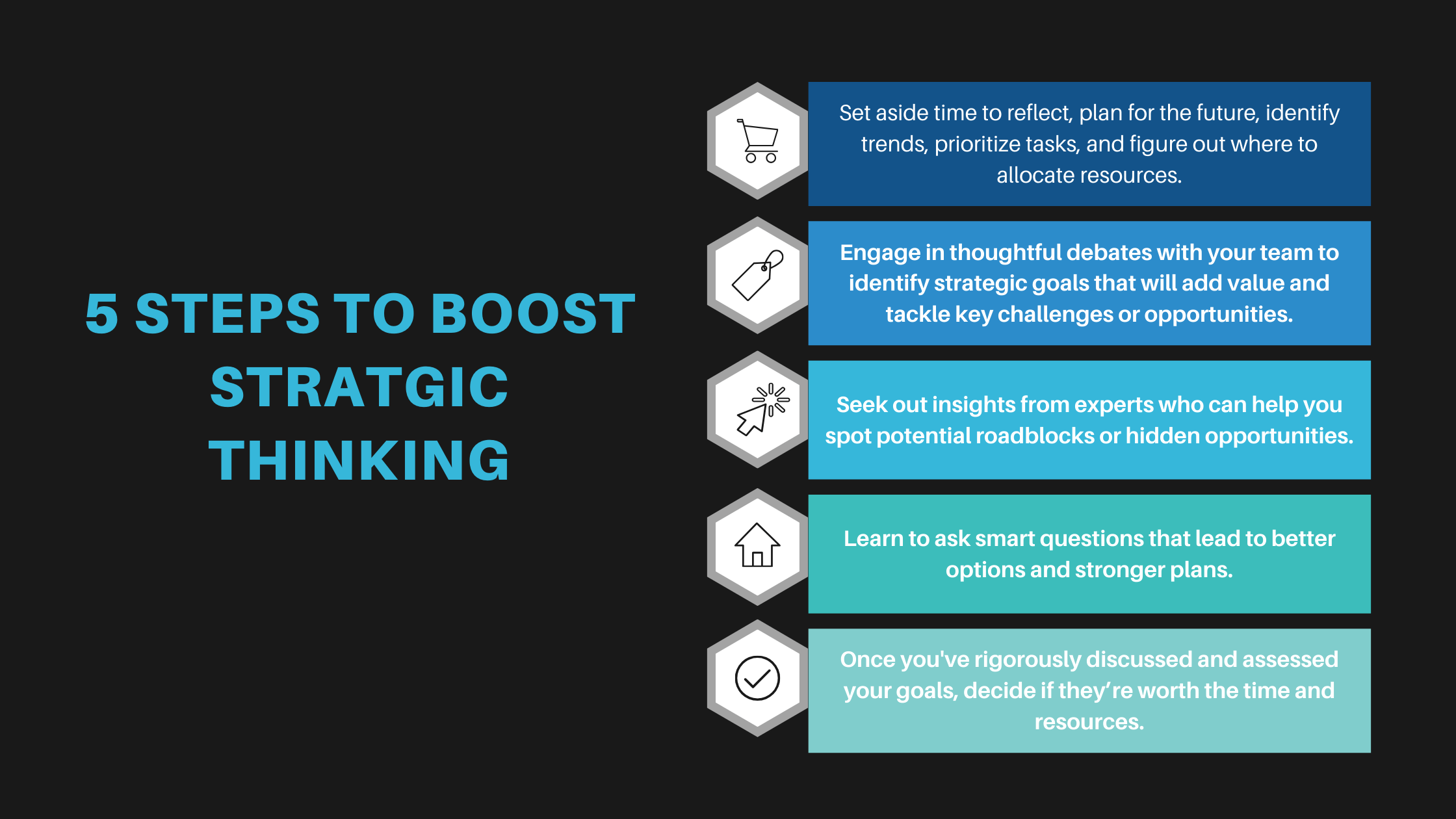What is Strategic Thinking?
Strategic thinking is all about being intentional and methodical analysis of the factors that could influence the long-term success of a business, team, or individual. It’s about looking ahead, anticipating challenges, and identifying opportunities that could give you an edge. Strategic thinking means considering risks, threats, and new possibilities. Ultimately, it leads to setting clear goals, formulating plans, and coming up with ideas that allow you to thrive in a competitive and ever-changing landscape. You must also factor in economic conditions, market trends, industry trends, tech trends and the resources you have on hand. To think strategically, you'll need a mix of skills; research, analysis, innovation, problem-solving, communication, and leadership, along with the ability to make decisive calls.
Why is Strategic Thinking Important?
In today’s fast-paced business world, the competitive landscape can shift in the blink of an eye. New trends may pop up unexpectedly, and if you don’t act on them, you risk falling behind. By incorporating strategic thinking into your daily routines, you'll sharpen your ability to anticipate, forecast, and seize opportunities. On a personal level, being a strategic thinker means you can contribute more in your role, making you indispensable to your organization. It’s also a great way to show that you're ready to take on bigger responsibilities.
What Does Strategic Thinking Look Like in Business?
In many organizations, strategic thinking comes into play during the strategic planning process. Leaders analyze internal and external data to form the company's strategic direction, or the products strategic direction. This strategy document guides the organization for the foreseeable future, helping leaders prioritize actions that will drive the company forward and helping product people to align the product vision & strategy to deliver on the company's strategic direction. Strategic thinking shouldn’t be limited to once-a-year meetings, though. It's essential to revisit and review your strategic initiatives throughout the year to ensure they're being executed and continuously add value. For business leaders, strategic thinking is crucial for deciding what products to offer, which markets to compete in, which customer segments to target, where to invest and how to allocate resources like time, staff, and capital. Leaders also need to enroll others in the strategic debate and in achieving key objectives and protecting resources from unnecessary risks.
Strategic Thinking in Product
The best strategic thinkers understand the future outcomes that they're working towards and they make decisions that have the highest likelihood of achieving those outcomes. They predict the future, based on what they know today; then they work to realise that future.
Good decisions create valuable outcomes in the future, and bad decisions lead to unnecessary risk. So, we can think of decisions as the basic building block of strategy. This is why strategic thinking is so important for product work. We're always making decisions; some short-term like “What should this button say?” and others that can have impact for months or years to come such as “What should we prioritize?”, and “What is important to focus on right now for our product?”. We can make those decisions tactically by thinking only about the immediate moment, or we can think about each decision strategically; a step towards unlocking a valuable sequence of future options, outcomes, and opportunities, in line with a vision.
Strategic thinking helps us make good decisions. But what exactly is a good decision? A good decision comes from having context and it is not necessarily a “right” decision, that is, a decision that has a successful outcome. We’re predicting the future, and we can’t ever know for certain whether we’ll be right, but if you do the work to gather as much context as possible; company strategy, product opportunities, industry trends, market trends, economic trends, etc, then you will be able to make the best decision, given those rich insights. Every decision involves risk and sometimes more risk means more opportunity for upside. So a good decision is one that strikes the right balance of risk and reward, inside of good context. Balancing agility with decisiveness is critical. Strategic thinkers need to commit to a plan while remaining open to new, promising opportunities. It’s all about staying adaptable while maintaining focus.
Again, I can't stress enough how important it is to get into a strategic debate with your team; strategy doesn't happen in a monologue and alone, it happens in a debate, where other perspectives are shared and debated about. Only then can you identify a great strategy.
How to Improve Strategic Thinking Skills Key Components of Strategic Thinking
Key Components of Strategic Thinking
When developing your company’s strategy, you’ll need to focus on several key areas:
- Analyzing business & product opportunities and risks.
- Evaluating the feasibility and cost of potential actions.
- Prioritizing goals and aligning them with the overall strategy.
- Anticipating competitors' actions and other external factors that could impact your plans.
- Reviewing industry, community and technology trends
How to Teach Strategic Thinking
One of the most effective ways to learn strategic thinking is by attending workshops led by experienced facilitators. A good workshop will provide hands-on opportunities to apply strategic thinking to real-world challenges and offer feedback on your strategic plan.
An effective strategic thinking workshop should include:
- Some learning on modern strategies and what strategy is and isn't.
- Group discussions on best practices and tools.
- Learning labs or simulations that allow you to practice strategic thinking immediately.
- Feedback and assessments of your current strategic thinking abilities.
- Guidance in developing a personalized plan to take back to work
As with any skill, you’ll improve at strategic thinking the more you practice it and the more experience you gain. It’s definitely worth the time and effort!


0 Comments